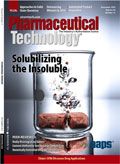Automated Inspection of Pharmaceutical Products
A conversation with Mike de la Montaigne, president of Eisai Machinery, USA Inc., about the possibilities for conducting fully automated product inspections.
PharmTech: What type of product(s) are amenable to visual inspection by a fully automated machine vision system?
de la Montaigne: Totally automated systems exist for visual inspection of both solid dosage and parenteral formulations. Parenteral products can be inspected inside their containers; that is in ampules, vials, or syringes. The containers themselves can also be inspected. The drug products can exist as liquids as well as in freeze-dried and powder preparations.
PharmTech: Which properties of parenteral formulations can you pick up with the existing fully automated technology?
de la Montaigne: Particulate matter, fill level, as well as any container defects can be detected.
PharmTech: The same machine can detect product quality as well as container quality?
de la Montaigne: Yes. That's correct. We can look for cracks in the container as well as particulate matter. Aggregates, on the other hand, present a challenge for current technology. We can identify their presence. We can reject a product with protein aggregates in it. The challenge now is to differentiate a particle from a protein. But that's being investigated by several companies, including ours.
Besides detecting particulates and container defects, it is also important to detect problems with the container closure. A manufacturer wants to ensure that the container is properly sealed. And container closure can also be assessed by a fully automated system.
PharmTech: What properties of solid dosage forms—tablets and capsules—can you detect with a fully automated system?
de la Montaigne: We have an automated, camera-based visual inspection system that scans for length, size, color, shape, and foreign materials on the product (not in). We have two different machines, one for tablets, and one for capsules.
PharmTech: At the moment, what are the limitations?
de la Montaigne: Not every product is amenable to automated inspection. Starting with parenteral products: It is not possible to find particulate matter in freeze-dried, lyophilized product, because the particulate is hidden in cake itself. No human or machine vision can see it. Some companies are developing X-ray detectors for that purpose.
Most of the other applications we've been able to manage successfully. If you can see it with the human visual system, then you should be able to see it with a camera and/or a sensor. But if you can't see it with human eye, then it will be a challenge for a camera. Dense suspensions are also a challenge because of the opacity of product.
PharmTech: What type of optical reader do these machines use?
de la Montaigne: Eisai's technology for particulate detection does not use a camera, but uses a static division (SD) sensor. The sensor is made up of an array of photodiodes that measure how much light passes through the product. The machine spins the containers, so that the particles are moving in front of the light source during the inspection process. As particles move in front of light, they block the light and create a voltage variation. Depending on the size of the variation, the machine rejects or accepts the product. The customer sets the spinning speed and determines what size of variation merits rejection. The particle's color and composition are unimportant. The sensor responds to the size of the particle. Any time it sees a particle greater than the threshold level set by operator, it generates a reject signal.
The machine uses cameras for cosmetic container inspection. Cameras are also used for our capsule and tablet systems. Other firms are using sensors that rely on Raman spectroscopy or near infrared technologies to detect properties of solid dosage forms.
PharmTech: What's the readout for your parenteral or solid-dosage systems?
de la Montaigne: Each device will produce a printout that gives you the number of particle rejects or cracked containers, for example.
PharmTech: Does the customer need any additional software to perform an analysis?
de la Montaigne: Not to analyze results, but often, a customer's MES [manufacturing-execution system] or ERP [enterprise-resource planning] system will be interfaced with the machine and can store and sort data as part of an overall batch analysis.
PharmTech: Is there any kind of corrective and preventive action (CAPA) system or feedback loop?
de la Montaigne: No CAPA per se, but for inline systems, you can, say, stop the production line if some specified number of products is rejected. The operator can set limits per camera station based on the number of rejects in order to take some corrective action.

Pharmaceutical Tariffs Are Imminent: How Industry is Bracing for Impact
April 16th 2025On April 14, 2025, the Trump Administration launched a national security-driven investigation into pharmaceuticals, a move that will likely result in tariffs being placed on pharmaceutical drugs, ingredients, and other components that are imported from outside of the United States.